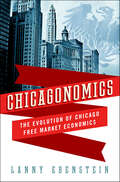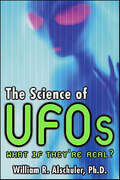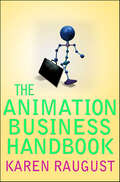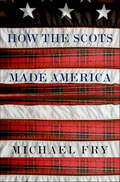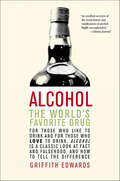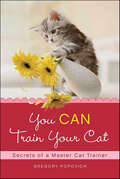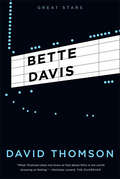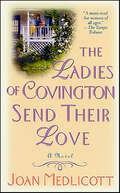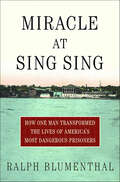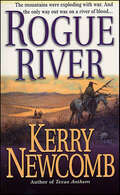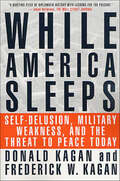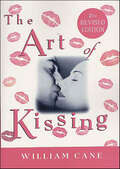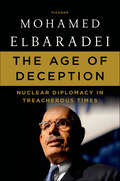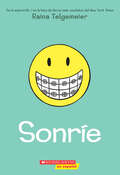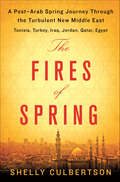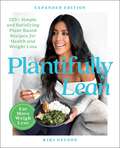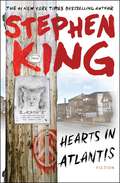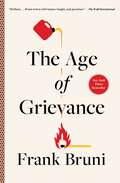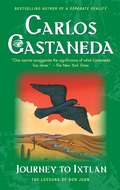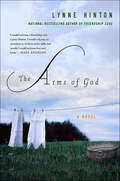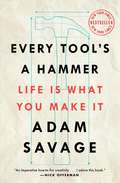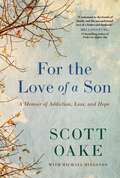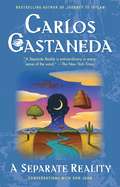- Table View
- List View
Chicagonomics: The Evolution of Chicago Free Market Economics
by Lanny EbensteinChicagonomics explores the history and development of classical liberalism as taught and explored at the University of Chicago. Ebenstein's tenth book in the history of economic and political thought, it deals specifically in the area of classical liberalism, examining the ideas of Friedrich Hayek and Milton Friedman, and is the first comprehensive history of economics at the University of Chicago from the founding of the University in 1892 until the present. The reader will learn why Chicago had such influence, to what extent different schools of thought in economics existed at Chicago, the Chicago tradition, vision, and what Chicago economic perspectives have to say about current economic and social circumstances.Ebenstein enlightens the personal and intellectual relationships among leading figures in economics at the University of Chicago, including Jacob Viner, Frank Knight, Henry Simons, Milton Friedman, George Stigler, Aaron Director, and Friedrich Hayek. He recasts classical liberal thought from Adam Smith to the present.
The Science of UFOs
by William R. AlschulerWhat if UFOs are real?Where could they be from, and how could they have traveled here? What advanced technology must they possess to execute the fantastic maneuvers they are routinely reported to make?Astronomer William R. Alshuler takes a fascinating look at the reported attributes of UFOs through the lens of known science and physics and explains how they might be doing the weird and incredible things they are known to do.Along the way, he examines the possibilities and problems of traveling faster than light, interdimensionally, and via teleportation, as well as the veracity of UFO reports, insights into potential alien motives, and alien biochemistry.
The Animation Business Handbook
by Karen RaugustToday, animation is more prevalent than ever in television, films, video games, and the Internet. Karen Raugust has created a much needed, comprehensive look at the entire business. She shows in detail how a successful animation studio or entrepreneur operates, describes the process of developing an animation property from the concept stage through the finished product, and outlines business methods used to create and sell animated media.Topics covered include:* Distribution, sales, and marketing methods* Financing, budgeting, costs and revenue opportunities* The creation of ancillary entertainment and merchandise* Animation in international markets.The Animation Business Handbook is the quintessential reference for anyone in or considering entering the animation industry.
How the Scots Made America
by Michael FryEver since they first set foot in the new world alongside the Viking explorers, the Scots have left their mark. In this entertaining and informative book, historian Michael Fry shows how Americans of Scottish heritage helped shape this country, from its founding days to the present. They were courageous pioneers, history-changing revolutionaries, great Presidents, doughty fighters, inspiring writers, learned teachers, intrepid explorers, daring frontiersmen, and of course buccaneering businessmen, media moguls, and capitalists throughout American history. The Scots' unflappable spirit and hardy disposition helped them take root among the earliest settlements and become some of the British colonies' foremost traders. During the Revolution, the teachings of the great Scottish philosophers and economists would help to shape the democracy that thrived in America as in no other part of the world. America may have separated from the British Empire, but the Scottish influence on the young continent never left.Armed with an inimitable range of historical knowledge, Fry charts the exchange of ideas and values between Scotland and America that led to many of the greatest achievements in business, science, and the arts. Finally, he takes readers into the twentieth century, in which the Scots serve as the ideal example of a people that have embraced globalization without losing their sense of history, culture and national identity.Scottish Americans have been incomparable innovators in every branch of American society, and their fascinating story is brilliantly captured in this new book by one of Scotland's leading historians. How the Scots Made America is not only a must-read for all those with Scottish ancestry but for anyone interested in knowing the full story behind the roots of the American way of life.
Fighting Cancer from Within: How to Use the Power of Your Mind for Healing
by Martin RossmanA breakthrough guide for cancer patients on using the mind to treat the body, from a pioneer in complementary medicineRecent research has shown that the mind can make a tremendous difference in not only the daily experience of living with cancer but also in the potential for overcoming it. In this groundbreaking book, Dr. Martin L. Rossman-hailed as "one of the greatest healers of our generation" by Rachel Naomi Remen-shows cancer patients how to use imagery in specific ways that can help them in their fight against cancer. Imagery is a natural, efficient way of storing and processing information, and one that has powerful effects on both emotional states and physiology. And while imagery is not a substitute for medical, surgical, or other physical approaches to cancer therapy, scientific studies have proven that it complements and enhances those treatments in many important ways. In this first book of its kind, Rossman provides specific ways to use imaging in fighting cancer.Praise for Guided Imagery for Self-Healing: "This superb collection of imagery techniques is a landmark contribution to the emerging field of behavioral medicine." -Joan Borysenko, Ph.D., author of Minding the Body, Mending the Mind
Alcohol: The World's Favorite Drug
by Griffith EdwardsAlcohol can be an item of diet, a medicine, sometimes an element in religious ritual. It is a valued object for the connoisseur, a traded commodity and a symbol of national pride (wine for instance in France, whisky in Scotland). The range of social and medical problems associated with alcohol and the history of related treatment methods (including the temperance movement, prohibition, AA and a range of contemporary approaches) are considered here. Already considered a classic in the field in England, Alcohol has proved to be fascinating reading for drinkers and nondrinkers alike.
You CAN Train Your Cat: Secrets of a Master Cat Trainer
by Gregory PopovichSince the beginning of time, cats have convinced the world that they are untrainable so they can do whatever they want...but those days are over! Gregory Popovich is a professional cat trainer who's trained cats to perform amazing circus-style tricks for television and stage, and he's about to reveal his most closely guarded secrets so cat lovers everywhere can put an end to the most common problems:- Stop bad litter box habits End early-morning howling Banish your cat from tabletops and countertops - Prevent begging before mealtime - Put an end to destructive clawing - Make peace between rival catsAnd so much more, including how to become an expert cat trainer at home and teach your cat to perform Gregory's favorite tricks, like jumping through a hoop or perching on your shoulders. This fun-to-read book also provides wonderful insights into the mysterious, complex feline mind, explaining why cats do the things they do so we can better understand them and enjoy a closer, more meaningful friendship.
Bette Davis (Great Stars)
by David Thomson"She could look demure while behaving like an empress. Blonde, with eyes like pearls too big for her head, she was very striking, but marginally pretty and certainly not beautiful . . . But it was her edge that made her memorable—her upstart superiority, her reluctance to pretend deference to others."Bette Davis was the commanding figure of the great era of Hollywood stardom, with a drive and energy that put her contemporaries in the shade. She played queens, jezebels, and bitches; she could out-talk any male costar; she warred with her studio, Warner Bros., worked like a demon, got through four husbands, was nominated for seven Oscars, and—no matter what—never gave up fighting. This is her story, from the acclaimed film critic David Thomson.
The Ladies of Covington Send Their Love: A Novel (Ladies of Covington)
by Joan MedlicottCautious Grace Singleton, uncertain of her place in an intimidating world. Outspoken Hannah Parrish, harboring private fear that may change her life. Fragile Ameila Declose, shattered by devastating grief. Circumstance has brought these disparate women of "a certain age" to a Pennsylvania boardinghouse where three square meals and a sagging bed is the most any of them can look forward to. But friendship will take them on a starting journey to a rundown North Carolina farmhouse where the unexpected suddenly seems not only welcome, but delightfully promising. And with nothing more than a bit of adventure in mind, each woman will be surprised to find that they years they've reclaimed from the shadow of twilight will offer something far more rare: confidence, competence, and even another chance at love...The Tampa Tribune calls Joan A Mendicott's The Ladies of Covington Send Their Love "A must-read for women of all ages."
Miracle at Sing Sing: How One Man Transformed the Lives of America's Most Dangerous Prisoners
by Ralph BlumenthalIn 1919, Lewis E. Lawes moved his wife and young daughters into the warden's mansion at Sing Sing prison. They shared a yard with 1,096 of the toughest inmates in the world-murderers, rapists, and thieves who Lawes alone believed capable of redemption. Adamantly opposed to the death penalty, Lawes presided over 300 executions. His progressive ideas shocked many, but he taught the nation that a prison was a community. He allowed a kidnapper to care for his children and a cutthroat to shave him every morning. He organized legendary football games for his "boys," and befriended Hollywood greats such as Charlie Chaplin and Humphrey Bogart. This is "A story almost too good to be true, but too true to miss." -Mario Cuomo
Rogue River (The Texas Anthem Series)
by Kerry NewcombThe captain was a madwoman with a scattergun. The soldiers were a whore, a surveyor's assistant, a writer, a crusty old Irishman, two murderous brothers, a criminal, and a county hunter. And the only way out of the mountains was on a frigid river that flowed toward the Missouri--a river running with blood.Texas-born Cole Anthem was the bounty hunter. He had followed an outlaw right into the middle of a major Indian uprising and a battle that turned into a slaughter. Now Cole and the other survivors of a raging Cheyenne war are taking the only chance they have: riding a woman's keelboat toward safety. But up and down the Rogue, a glory-mad chief hasn't given up. His warriors are armed and waiting--to spill the white men's blood...
While America Sleeps: Self-Delusion, Military Weakness, and the Threat to Peace Today
by Donald Kagan Frederick KaganIn While England Slept Winston Churchill revealed in 1938 how the inadequacy of Britain's military forces to cope with worldwide responsibilities in a peaceful but tense era crippled its ability to deter or even adequately prepare for World War II.In While America Sleeps, historians Donald and Frederick Kagan retrace Britain's international and defense policies during the years after World War I leading up to World War II, showing in persuasive detail how self-delusion and an unwillingness to face the inescapable responsibilities on which their security and the peace of the world depended cost the British dearly. The Kagans then turn their attention to America and argue that our nation finds itself in a position similar to that of Britain in the 1920s. For all its emergency interventions the U.S. has not yet accepted its unique responsibility to take the lead in preserving the peace. Years of military cutbacks-the "peace dividend" following the buildup and triumph over Communism of the Reagan years-have weakened our armed forces and left us with too few armed forces to cover too many possible threats. This has caused us to bank everything on high tech "smart" weapons - some of which have not yet been invented and others that we are not acquiring or deploying - as opposed to the long-term commitment of money, fighting men and women, and planning that the deterrence of a major war would require. This failure to shape a policy and to commit the resources needed to maintain peace has cost valuable time in shaping a peaceful world and has placed America's long-term security in danger.The policies of the Bush and Clinton administrations have left us in a position where we cannot avoid war and keep the peace in areas vital to our security. Neither have the post-Cold War policies sent clear signals to would-be aggressors that the U.S. can and will resist them. Tensions in the Middle East, instability in eastern Europe and the former Soviet Union, the nuclear confrontation between India and Pakistan, the development of nuclear weapons and missiles by North Korea, and the menacing threats and actions of China, with its immense population, resentful sense of grievance and years of military buildup, all hint that the current peaceful era will not last forever. Can we make it last as long as possible? Are we prepared to face its collapse? While America Sleeps is a sobering, fascinating work of history that poses a thoughtful challenge to policy-makers and will interest military buffs as well as readers interested in history and international relations.
The Art of Kissing
by William CaneIn The Art of Kissing, William Cane reveals that there is more to kissing than simply locking lips. Through a hundred thousand interviews he has discovered the truth about what men and women do, think, and feel when they kiss. Their input and his expert knowledge can help you to master the secrets of great kissing. With specific techniques for more than thirty types of kisses, this updated and revised edition features:* Overcoming first kiss shyness* Secrets to increasing your 'kissability'* Complete instructions on French Kissing* Electric kisses, neck kisses, ear kisses and much moreTransform your kissing technique, pucker up with passion, and master The Art of Kissing today!
The Age of Deception: Nuclear Diplomacy in Treacherous Times
by Mohamed ElBaradeiFor the first time, the Nobel Prize laureate and "man in the middle" of the planet's most explosive confrontations speaks out—on his dealings with America, negotiations with Iran, reform and democracy in the Middle East, and the prospects for a future free of nuclear weapons.For the past two decades, Mohamed ElBaradei has played a key role in the most high-stakes conflicts of our time. Unique in maintaining credibility in the Arab world and the West alike, ElBaradei has emerged as a singularly independent, uncompromised voice. As the director of the UN's International Atomic Energy Agency, he has contended with the Bush administration's assault on Iraq, the nuclear aspirations of North Korea, and the West's standoff with Iran. For their efforts to control nuclear proliferation, ElBaradei and his agency received the 2005 Nobel Peace Prize.Now, in a vivid and thoughtful account, ElBaradei takes us inside the international fray. Inspector, adviser, and mediator, ElBaradei moves from Baghdad, where Iraqi officials bleakly predict the coming war, to behind-the-scenes exchanges with Condoleezza Rice, to the streets of Pyongyang and the trail of Pakistani nuclear smugglers. He dissects the possibility of rapprochement with Iran while rejecting hard-line ideologies of every kind, decrying an us-versus-them approach and insisting on the necessity of relentless diplomacy. Above all, he illustrates that the security of nations is tied to the security of individuals, dependent not only on disarmament but on a universal commitment to human dignity, democratic values, and the freedom from want.Probing and eloquent, The Age of Deception is an unparalleled account of society's struggle to come to grips with the uncertainties of our age.
Sonríe (Smile)
by Raina Telgemeier¡El cómic autobiográfico de Raina Telgemeier, ganadora del premio Eisner!Raina solo quiere ser una estudiante normal de sexto grado, pero una noche al salir de las Girl Scouts se cae y se rompe los dos dientes incisivos. Lo que sigue es un viaje largo y frustrante con aparatos de ortodoncia intermitentes, cirugías y hasta un retenedor con dientes postizos. Encima de todo eso, tiene que lidiar con un terremoto, una confusión con los chicos y unos amigos que resultan no ser tan amigables.Raina Telgemeier's #1 New York Times bestselling, Eisner Award-winning graphic memoir based on her childhood!Raina just wants to be a normal sixth grader. But one night after Girl Scouts she trips and falls, severely injuring her two front teeth. What follows is a long and frustrating journey with on-again, off-again braces, surgery, embarrassing headgear, and even a retainer with fake teeth attached. And on top of all that, there's still more to deal with: a major earthquake, boy confusion, and friends who turn out to be not so friendly.
The Fires of Spring: A Post-Arab Spring Journey Through the Turbulent New Middle East—Tunisia, Turkey, Iraq, Qatar, Jordan, Egypt
by Shelly CulbertsonTurkey, Iraq, Qatar, Jordan, Egypt, and TunisiaThe “Arab Spring” all started when a young Tunisian fruit seller set himself on fire in protest of a government official confiscating his apples and slapping his face. The aftermath of that one personal protest grew to become the Middle East movement known as the Arab Spring—a wave of disparate events that included protests, revolutions, hopeful reform movements, and bloody civil wars.The Fires of Spring is the first book to bring the post-Arab Spring world to light in a holistic context. A narrative of author Shelly Culbertson’s journey through six countries of the Middle East, The Fires of Spring tells the story by weaving together a sense of place, insight about issues of our time, interviews with leaders, history, and personal stories. Culbertson navigates the nuances of street life and peers into ministries, mosques, and women’s worlds. She delves into what Arab Spring optimism was about, and at the same time sheds light on the pain and dysfunction that continues to plague parts of the region. The Fires of Spring blends reportage, travel memoir, and analysis in this complex and multifaceted portrait.
Plantifully Lean: 125+ Simple and Satisfying Plant-Based Recipes for Health and Weight Loss: A Cookbook
by Kiki NelsonGive Mom the gift of vibrant health with Plantifully Lean—over 125 simple, plant-based recipes and a four-week meal plan to nourish her body and soul.When Kiki Nelson adopted a plant-based, low-fat diet, she lost seventy pounds and reversed her risk for diabetes and heart disease. While a few programs had previously helped her lose some weight, it took going all in on plants to resolve her health issues and maintain her weight loss. In Plantifully Lean, Kiki shares more than 125 wide-ranging, simple recipes and the four-week meal plan that were key to her success. Covering every meal plus snack attacks, Plantifully Lean includes simple recipes such as Mediterranean Pasta Salad, Blueberry Vanilla Pancakes, Warm White Bean and Potato Salad, Roasted Cauliflower with Pesto, Microwave Potato Chips, Shiitake Rice with Bok Choy and Thai Peanut Sauce, French Onion Soup, Sweet Potato Tacos, Mini Oat Bars, and Caramel Apple Streusel. When you&’re eating a plant-based diet this satisfying and delicious, you&’ll feel energized and motivated—never hungry or bored. Originally shared with her online community, this new edition of Plantifully Lean has been redesigned to be even easier to use and expanded with new information, inspiration, and photos. To make a plant-based diet part of your healthy lifestyle, Plantifully Lean includes the following: -Meal prep guidelines and tips -Low-fat, plant-based comfort foods that will cover your cravings -Lists of &“high-volume foods,&” or foods that are both healthy and filling and that are perfect for snacking and swapping into recipes -Charts for balancing your plate with grains and produce -Nutritional information for each recipe Plantifully Lean was written to help anyone find health and well-being, whether they aim to lose weight, stave off diabetes, lower cholesterol, or address elevated blood pressure. Kiki writes with the warmth and vulnerability of someone who&’s been there, and includes inspiration on every page. Plantifully Lean will help you change from the inside out.
Hush, Hush: The Complete Collection (The Hush, Hush Saga #1)
by Becca FitzpatrickNora finds forbidden love with her fallen angel, in the first book in the New York Times bestselling Hush, Hush saga.For Nora Grey, romance was not part of the plan. She's never been particularly attracted to the boys at her school, no matter how much her best friend, Vee, pushes them at her. Not until Patch came along. With his easy smile and eyes that seem to see inside her, Nora is drawn to him against her better judgment. But after a series of terrifying encounters, Nora's not sure who to trust. Patch seems to be everywhere she is, and to know more about her than her closest friends. She can't decide whether she should fall into his arms or run and hide. And when she tries to seek some answers, she finds herself near a truth that is way more unsettling than anything Patch makes her feel. For Nora is right in the middle of an ancient battle between the immortal and those that have fallen - and, when it comes to choosing sides, the wrong choice will cost her life.
Hearts In Atlantis (Thorndike/g. K. Hall Paperback Bestsellers Ser.)
by Stephen KingThe classic collection of five deeply resonant and disturbing interconnected stories from #1 New York Times bestselling author Stephen King.Innocence, experience, truth, deceit, loss, and recovery are at the core of these five interconnected, sequential tales—each deeply rooted in the 1960s, and each scarred by the Vietnam War, which continues to cast its shadow over American lives, politics and culture. In Part One, &“Low Men in Yellow Coats,&” eleven-year-old Bobby Garfield discovers a world of predatory malice in his own neighborhood. He also discovers that adults are sometimes not rescuers but at the heart of the terror. In the title story, a bunch of college kids get hooked on a card game, discover the possibility of protest, and confront their own collective heart of darkness, where laughter may be no more than the thinly disguised cry of the beast. In &“Blind Willie&” and &“Why We&’re in Vietnam,&” two men who grew up with Bobby in suburban Connecticut try to fill the emptiness of the post-Vietnam era in an America which sometimes seems as hollow—and as haunted—as their own lives. And in &“Heavenly Shades of Night Are Falling,&” this remarkable book&’s denouement, Bobby returns to his hometown where one final secret, the hope of redemption, and his heart&’s desire may await him. Full of danger and suspense, full of heart, this spellbinding fiction will take some readers to a place they have never been...and others to a place they have never been able to completely forget. Nearly twenty years after its first publication, Hearts in Atlantis is powerful and astonishingly current. &“You will see Stephen King in a new light. Read this moving, heartfelt tragedy and weep—weep for our lost conscience.&” —BookPage
The Age of Grievance
by Frank BruniNEW YORK TIMES BESTSELLER • &“Brilliant...Bruni writes with humor, insight, and precision.&” —Wall Street Journal • &“The best prescription for our redemption.&” —The New York Times • &“A wise and humane book for our foolish and cruel era.&” —Jonathan Haidt, author of The Anxious Generation From bestselling author and longtime New York Times columnist Frank Bruni comes a lucid, powerful examination of the ways in which grievance has come to define our current culture and politics, on both the right and left.The twists and turns of American politics are unpredictable, but the tone is a troubling given. It&’s one of grievance. More and more Americans are convinced that they&’re losing because somebody else is winning. More and more tally their slights, measure their misfortune, and assign particular people responsibility for it. The blame game has become the country&’s most popular sport and victimhood its most fashionable garb. Grievance needn&’t be bad. It has done enormous good. The United States is a nation born of grievance, and across the nearly two hundred and fifty years of our existence as a country, grievance has been the engine of morally urgent change. But what happens when all sorts of grievances—the greater ones, the lesser ones, the authentic, the invented—are jumbled together? When people take their grievances to lengths that they didn&’t before? A violent mob storms the US Capitol, rejecting the results of a presidential election. Conspiracy theories flourish. Fox News knowingly peddles lies in the service of profit. College students chase away speakers, and college administrators dismiss instructors for dissenting from progressive orthodoxy. Benign words are branded hurtful; benign gestures are deemed hostile. And there&’s a potentially devastating erosion of the civility, common ground, and compromise necessary for our democracy to survive. How did we get here? What does it say about us, and where does it leave us? The Age of Grievance examines these critical questions and charts a path forward.
Journey To Ixtlan: The Lessons Of Don Juan (The Teachings of Don Juan #3)
by Carlos Castaneda&“Don Juan&’s reality remains alluring.&” —Chicago Tribune Embark on a profound journey of self-discovery with Carlos Castaneda as he experiences his own final voyage into the teachings of don Juan, sharing with us what it is like to truly &“stop the world&” and perceive reality on his own terms.In this third installment of the groundbreaking series, Castaneda delves into the mystical teachings of don Juan, a wise Yaqui Indian spiritual leader. What begins as a quest for knowledge about mind-altering plants evolves into a deeper realization: the true path to understanding reality lies in "stopping the world" and reshaping one's perception. Blending anthropology, spirituality, and philosophy, this captivating narrative challenges conventional beliefs and offers timeless wisdom. A cornerstone of spiritual literature, Journey to Ixtlan invites readers to question their assumptions and explore alternative dimensions of thought and awareness.
The Arms of God: A Novel
by Lynne HintonAlice is making her daughter dinner when her mother Olivia, who left her at a day care center when she was four-years-old, appears at her door. Although Alice has managed to navigate an unforgiving foster care system to build a good life for herself, she has never really recovered from her mother's disappearance. Olivia's sudden reappearance is like a quiet, unexplained gift. Over the next couple of weeks Alice asks Olivia to dinner. Olivia is always dropped off by a friend and sits peacefully as Alice and her daughter talk over the meal. One afternoon Alice gets a call from the hospital telling her that Olivia is dead. The only identification the hospital could find was Alice's number with the word "daughter" written underneath it. She goes to pick up Olivia's things and finds the key to her apartment. It is here that the mystery of Olivia's past is slowly uncovered and Alice begins to understand how the power of hatred can hold a woman down and how the power of friendship can lift her up again. Not since her bestselling book The Friendship Cake has Hinton created characters who are so filled with heartache and fragile hope, that they will become a permanent part of the reader's life.
Every Tool's a Hammer: Life Is What You Make It
by Adam SavageIn this New York Times bestselling &“imperative how-to for creativity&” (Nick Offerman), Adam Savage—star of Discovery Channel&’s Mythbusters—shares his golden rules of creativity, from finding inspiration to following through and successfully making your idea a reality.Every Tool&’s a Hammer is a chronicle of my life as a maker. It&’s an exploration of making, but it&’s also a permission slip of sorts from me to you. Permission to grab hold of the things you&’re interested in, that fascinate you, and to dive deeper into them to see where they lead you. Through stories from forty-plus years of making and molding, building and breaking, along with the lessons I learned along the way, this book is meant to be a toolbox of problem solving, complete with a shop&’s worth of notes on the tools, techniques, and materials that I use most often. Things like: In Every Tool There Is a Hammer—don&’t wait until everything is perfect to begin a project, and if you don&’t have the exact right tool for a task, just use whatever&’s handy; Increase Your Loose Tolerance—making is messy and filled with screwups, but that&’s okay, as creativity is a path with twists and turns and not a straight line to be found; Use More Cooling Fluid—it prolongs the life of blades and bits, and it prevents tool failure, but beyond that it&’s a reminder to slow down and reduce the friction in your work and relationships; Screw Before You Glue—mechanical fasteners allow you to change and modify a project while glue is forever but sometimes you just need the right glue, so I dig into which ones will do the job with the least harm and best effects. This toolbox also includes lessons from many other incredible makers and creators, including: Jamie Hyneman, Nick Offerman, Pixar director Andrew Stanton, Oscar-winner Guillermo del Toro, artist Tom Sachs, and chef Traci Des Jardins. And if everything goes well, we will hopefully save you a few mistakes (and maybe fingers) as well as help you turn your curiosities into creations. I hope this book serves as &“creative rocket fuel&” (Ed Helms) to build, make, invent, explore, and—most of all—enjoy the thrills of being a creator.
For the Love of a Son: A Memoir of Addiction, Loss, and Hope
by Scott Oake#1 National Bestseller From Hockey Night in Canada&’s Scott Oake, a raw and honest memoir about his son&’s struggle with opioid use and how he turned a father&’s worst nightmare into a second chance for others battling addiction.A father&’s love. A devastating drug crisis. A stirring call to action. When veteran broadcaster Scott Oake first held his infant son, Bruce, in his arms, he never imagined that Bruce would become a statistic in the losing battle to opioid abuse. In those early days, Scott, a new father, watched Bruce with awe, marveling at the potential of his funny, charismatic boy. As Bruce got older, though, he struggled to fit in at school and began showing signs of having ADHD, including a streak of impulsiveness that often got him into trouble. Scott and his wife, Anne, did their best to support him, and for a time, he found community and belonging in boxing and local rap battles. But when Bruce was pulled into a world of drugs and gangs, Scott and Anne experienced a crash course in the reality of loving someone battling substance use disorder. Then one quiet day in 2011, Scott got the phone call that every parent dreads: Bruce had accidentally overdosed. At just twenty-five, Scott&’s vibrant, creative, first-born son was gone forever. It was a loss that could have broken a man, a marriage, a family—but Scott, Anne, and their younger son, Darcy, instead turned the worst day of their lives into a way to help the thousands of Canadians struggling with addiction. After nearly a decade of fundraising and battling red tape and political machinations they launched the Bruce Oake Recovery Centre, a free, revolutionary treatment centre staffed by addicts and alcoholics in recovery. For the Love of a Son is the story of a father&’s unconditional love for his son. Above all, it&’s the story of a young man who never got to grow up and a family who gives others the chance to find their way home.
Separate Reality: Conversations With Don Juan
by Carlos Castaneda&“One can&’t exaggerate the significance of what Castaneda has done.&” (The New York Times) In this captivating work, Carlos Castaneda shares the story of how he returns to don Juan to resume the journey necessary to become &“a man of knowledge&” venturing into the world of mystical sensation and perception to see beyond the surface realities of life.As the second volume in the intriguing twelve-part series, this book invites you to experience a reality beyond the ordinary. Delve into the profound teachings of the wise Yaqui Indian spiritual leader, don Juan Matus, as anthropologist Carlos Castaneda recounts his incredible apprenticeship. Through the exploration of hallucinogenic substances and ancient wisdom, Castaneda challenges conventional perceptions, leading readers into a deeply thought-provoking journey of self-discovery and consciousness exploration. Combining elements of anthropology and mysticism, this masterpiece continues to captivate, inspire, and influence those seeking deeper understanding and enlightenment.
